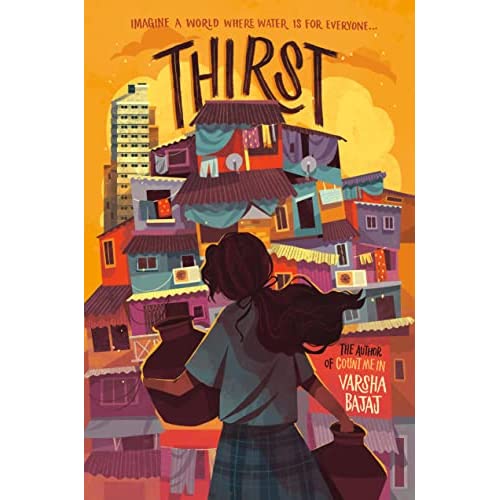Thirst
Thirst, by Varsha Bajaj, focuses on Minni, a girl who lives in the poorest part of Mumbai and faces the consequences of a water crisis.

When I first started teaching social studies, I had an eye-opening conversation with a student. We were studying ways of life in Kenya, and after seeing photos of Nairobi, the student expressed shock that there were skyscrapers in the capital city. I realized that I had not given students a full picture of life in Kenya, focusing on the life of the Maasai in rural areas and failing to highlight how there are diverse ways of life throughout the country. I've since shifted how I teach about other countries.

I think this is one reason why I like Thirst, by Varsha Bajaj, since it gives us a glimpse into multiple ways of life in Mumbai. The story focuses on Minni, a girl who lives in the poorest part of Mumbai. Minni's family faces some serious challenges. They work hard to make sure they can pay Minni's school fees, but this becomes more difficult when Minni's mom gets sick from contaminated drinking water. Minni takes over her mom's job as a servant for a richer family, and tries to balance her new role and her schoolwork. Through Minni's eyes, we see the life of a rich family who live in one of the shiny skyscrapers. Access to water, expensive food, or education is not a a concern for them.
By contrast, water is positioned as the most pressing concern for Minni and her family. Water is only available at a public tap for two hours every morning and one hour at night, which means that women have to line up daily for extended periods. With climate change shortening the monsoon season, water shortages have increased and led to heightened tensions in her community. To make matters worse, Minni's brother runs afoul of the water mafia, people who steal and resell water for high prices. As her mother becomes ill from a water-borne disease, Minni feels the full brunt of these water shortages.
While there are many difficulties, we also see that Minni is supported by her community. She has a strong relationship with her family, and many people in her community are ready to offer her support when she needs it. While other authors might tell the story with a deficit focus, Varsha Bajaj chooses instead to focus on the systemic obstacles that Minni faces, while emphasizing the community supports and hard work that help her succeed. This middle grade book offers a window into the life of a girl living in Mumbai that should be illuminating for upper elementary and middle years students.
